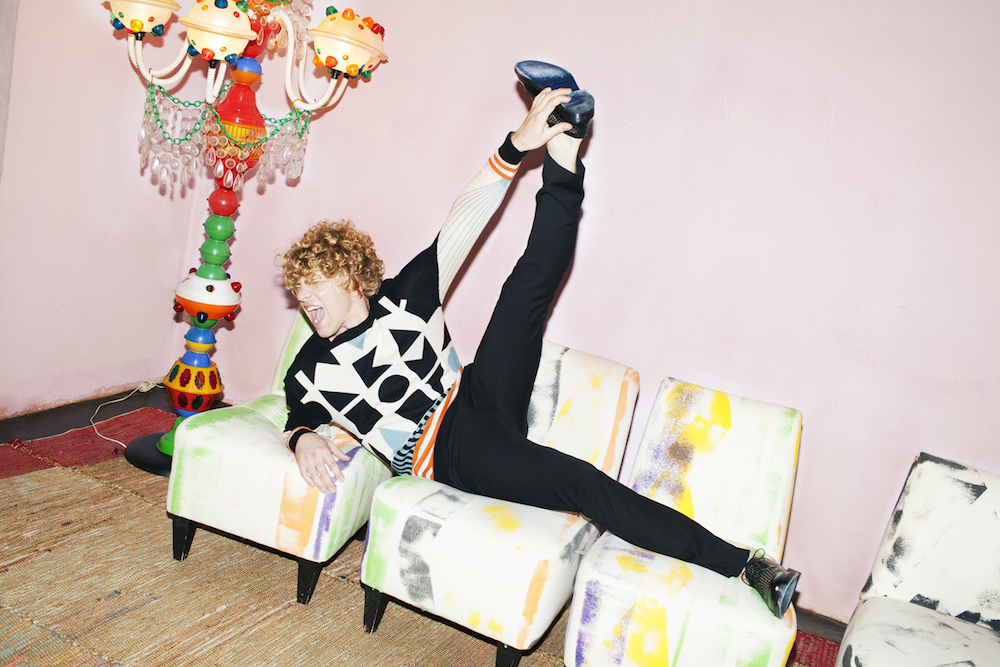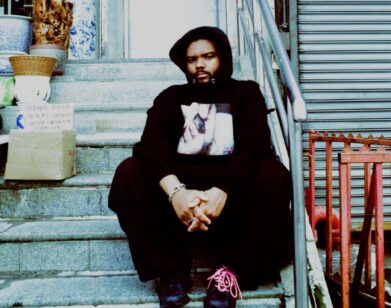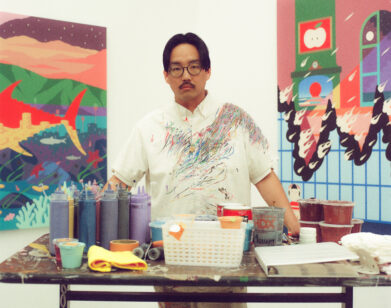The Intergenerational Curator
ABOVE: TIM GOOSSENS AT THE HOME OF IZHAR PATKIN IN NEW YORK, DECEMBER 2014. PHOTOS BY KATE OWEN. STYLING: ALPHA VOMERO/SEE MANAGEMENT. GROOMING: LAURA DELEON FOR ORIBE HAIR CARE/JOE MANAGEMENT.
When Tim Goossens moved to New York in 2006, it was for love and nothing more. Less than a year later, however, the independent curator had separated from his boyfriend and found himself working under Klaus Biesenbach as MoMA PS1’s first-ever intern in the Department of Media and Performance Art, emailing artists such as Marina AbramoviÄ?.
Before taking a serious interest in and studying art history at the Sorbonne and the École du Louvre, the Belgian-born curator received a degree in nursing, worked at a hospital, and auditioned, but was rejected for theater school. Until an ex-boyfriend suggested the subject, art history had never even crossed his mind. But over the past eight years, Goossens has risen from intern to curator, and now teaches at Sotheby’s Institute of Art.
Just last year, Goossens co-curated India’s first sound art exhibition, “Listen Up!,” which included artists like Yoko Ono, Jason Singh, Nils Bech, and Japanther. He also worked on an array of exhibitions–photography, video, and collage–and featured both emerging and established artists like Nancy Holt, Patti Smith, and Joan Jonas in the show “Dark Paradise” at The Clocktower, a non-profit arts organization with which he works closely. In December, he spearheaded Select Art Fair during Miami Art Week, and differentiated the fair from others by giving booths to artists such as Rashaad Newsome, rather than only galleries.
The mixing of intergenerational artists and mediums has become a fixture of Goossens’s exhibitions, and although many of his upcoming projects for 2015 are still under wraps, we can expect headlining shows that include some of the aforementioned artists. In addition to independent shows, he will co-curate the Aurora Festival in Dallas with the goal of rethinking the festival into a biennial new media experience. In October, “Listen Up!” will travel to the U.K. at the Yorkshire Sculpture Park.
We spoke with Goossens at the home of his friend the artist Izhar Patkin the day after he returned from Art Basel Miami Beach. Despite recovering from the party-centric week, he had unending charisma and charm.
AGE: 34
NATIONALITY: BELGIAN
ENTERING THE ART WORLD: I handed in my two theses [at graduate school], came to New York for like three weeks, and went to a Chicks on Speed concert at MoMA in June 2006 during the World Cup and was front row. I was wearing something gold so New York Magazine wrote about it. Then in October, [after I moved to New York], I went to the [Édouard] Manet opening and Klaus [Biesenbach] came up to me and was like, “You were at the concert. Do you know they wrote about you?” The next day his assistant sent me the article, and then it turned out they were looking for an intern because he just started the Department of [Media and] Performance Art, and then I was their first intern. I worked there for a year, went to Venice with PS1, and then the next week Alanna Heiss called me like, “I heard about you.” [laughs] I’m like, “Yeah, we also met last week.” She’s was like, “I need an assistant. Are you looking for a job?”
RECOGNIZING THE UNDER-RECOGNIZED: I feel like I learned a lot from Alanna and PS1 where the focus is on under-recognized artists who might be older, which I feel very strongly about, or young artists, which other places do as well. They’re also very good at doing group shows, which is not necessarily a very American thing to do. My first show at PS1 was a group show called “Between Spaces,” in November 2009 with Sam Moyer, Alex Da Corte, David Altmejd–all those kids who are now big. So I feel like I grew up with them as well.
THE MOST ‘WOW’ EXHIBIT: Joan [Jonas] was in my show last year, the “Dark Paradise” one. That’s the show I feel the most wow about so far, because it combined a lot of things I like, including the intergenerational thing. Nancy Holt was in it as well, who was kind of forgotten and then passed away few months later, and Patti Smith, who’s in her late sixties.
THE INTERGENERATIONAL THING: I feel like it’s more exciting because you see it not in a mentor-student kind of way, but that the older people can be cool or relevant too. I try to stay away from too literal kind of things. We’re thinking about a show for this summer that The Clocktower will do. We’ll be working with The Knockdown Center, where we might do an all-female show, where someone like Laurie Anderson might pick a student of hers, which I feel might be too didactic almost…
SECOND BEST: Doug Aitken was doing “Sleepwalkers” like a month after I started [at PS1]. It was a collaboration with Creative Time and the new department. Bloomberg was there, Tilda Swinton, [there was] a press conference in the garden, all that. Then there was an after party, and [another prominent curator] was like, “Oh I have to go home alone now.” I thought that was so sad. I was like, “I never want to be number one if it means not being able to have a family,” which I know now is not true. But I remember being like, “I’d rather be number two and have a family.”
OVERCOMING FEARS AND INTIMIDATION: The medical experience from before, having patients die on me kind of equalized everyone. We would have a CEO or maybe a blue-collar person die, but in the end, they all die. They were all in the same hospital room begging for the same thing or in the same pain. Coming here knowing that in the end we’re all human, I think that helped me, that grounded me a lot. Even though it’s super weird I had that experience, I think it did help me understand certain [things].
ODD ONE OUT: My family actually didn’t go to many museums [growing up]. It was just me. I went to London on my own when I was 15 to visit the British Museum, which I knew from books. I was obsessed with Egypt as a child–the art and hieroglyphs and portraits. So I’m kind of a weird one in the family, not even just my sexuality: I’m the first one to move abroad; I studied in Antwerp; I did nursing school.
ON PASSION: I worked in psychiatry as a night nurse, and I’m not saying that artists are crazy, but there was a certain ambition or drive. You wake up and that’s what you need to do, which some illnesses have too. I think passion…that’s what I dislike, when my students don’t have this drive. It doesn’t mean that you have to be at every opening; it’s just like, start your own blog and write about art. It’s a necessity that you want to be around art and artists.
LET THE ARTISTS SPEAK: Alanna gave me a lot of positive advice, [like] to give the artists freedom. I feel like we’ve gotten into an age where the curator is almost more important, so it’s interesting to me that someone like her or Marcia Tucker, who started the New Museum, didn’t have that need to be like, “The curator has to come first,” and they were so successful. I think if you pick the right people and give them their platform it will shine back on you as the mastermind behind it.
For more from the 15 Faces of 2015, click here.







